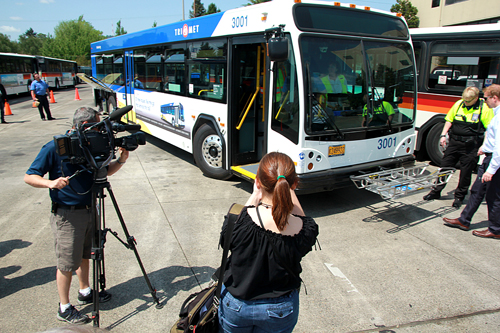
On a warm and breezy afternoon last Thursday, TriMet officials and operators met with the press and public to admire, observe and ride on a prototype bus for the agency’s new fleet coming this summer. Among all the cuts, downgrades and layoffs, 55 brand new buses will hopefully put a gleam on some of the more drastic changes TriMet faces this summer with the beginning of its next fiscal year—one in which TriMet’s budget falls short some $12 million.
The new buses, including 51 standard diesel buses and 4 hybrid buses, are slated to take to the pavement beginning sometime in late summer, replacing an equal number of older buses. About 150 of TriMet’s buses are more than 18 years old, some having seen more than two decades of use. According to TriMet Maintenance Supervisor Mark Nelson, those buses are past due for replacement by federal standards. “The average bus age, per the federal government, is about 12 years. TriMet is about double that,” Nelson said, casting an eye toward the sleek new behemoth sitting idle to the side.
The buses are flashy, looking like updated versions of TriMet’s blue, white and yellow low-floor buses from 2009. A streamlined front end fitted with prototype LED headlights that move in correspondence to the direction the bus is turning, and a longer, more gradual sloping boarding ramp make for a stylish transport.
On the whole, the new fleet will be a major step up from the older, rambling buses that crowd Portland streets, but not one that is necessarily noticeable to the everyday rider. Apart from a smoother ride and large windows spanning almost the entire length of the 42-foot bus, giving the interior a pleasant new brightness, the most notable changes are under the hood.
The new buses, manufactured by Gillig in Hayward, Calif., will feature electrified cooling systems used by NASCAR, already equipped in 104 currently used buses. The system replaces the standard hydraulic or mechanical fan system and improves fuel mileage by 5–10 percent. Other features include technology that reduces nitrogen oxide emissions from exhaust, quieter starters, larger tires for smoother rides and, for the winter, pre-installed automatic drop-down chains, deployed and fitted at the push of a button.
“The difference is quite a bit of new technology: lower emissions, higher fuel mileage and a number of creature comforts to better serve the public, including climate control, increased security and camera systems, increased seating—cleaner, brighter, lighter across the board,” Nelson said of the new buses.
The purchase of 55 buses, some of which carry an individual price tag of $625,000, inevitably calls to mind the economic strains TriMet finds itself in with the coming fiscal year. Indeed it may call into question the transparency of the agency’s monetary inner-workings. But, 93 percent of the cost—totaling $24,975,275—will be funded through federal grants.
While this still leaves TriMet with a hefty bill of $1,748,270, rider Meagan Duncan sees the purchase as a wise display of spending. “I see it as a necessary thing,” she said. “Especially on my end of town at the Merlo Garage, we have a lot of the older buses. They consistently break down, and when they break down, they cause delays of upward of 45 minutes. It’s going to be interesting to see how things continue to work. I think in the end this will be for the better,” Duncan added.
Passengers are not the only ones excited about a new and improved ride. “I like the visibility,” said TriMet driver Denise Ulabarro. “Having the big windows and the side windows—I think they’re a huge benefit to the driver. The vision barriers are a lot smaller, so that’s going to help,” she added. “It’s just going to be better.”
After circling the bus with mechanics, inspecting the tubes and wires under the flip up panels, everyone climbed on, and Ulabarro took the new bus and its passengers for a spin through downtown. Sitting on the blue vinyl seats, the first passengers seemed to be enjoying themselves. “So far I’m liking it,” Duncan said. “It’s a smoother ride if there’s bumps in the road, if you’re going over potholes and whatnot. It’s a lot nicer now.”
As for the most noticeable difference, a smooth ride seemed to come to the fore for riders. “Well, you don’t have any bumps,” said Tom Selliken, one of the three public riders chosen to preview the bus.
“The pilot bus has only been on the property since about April,” Nelson said. “We’re still in the testing phase. Once again, this is the prototype or the pilot for all the production buses that will start on June 19. We’re still getting some input from the drivers, and we’re still making some changes,” he said. “This will be the template for the 40-foot diesel bus for the next five years.”

